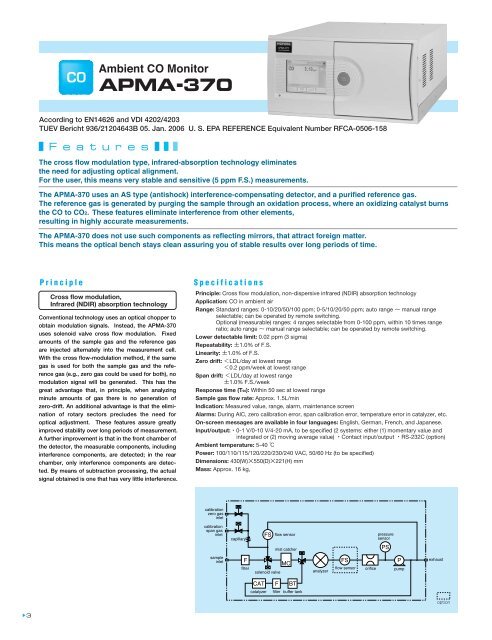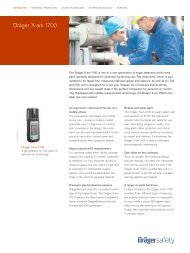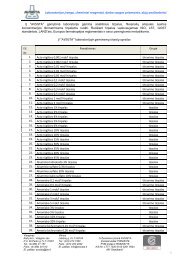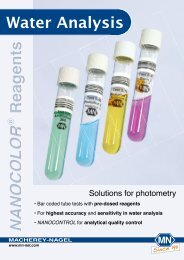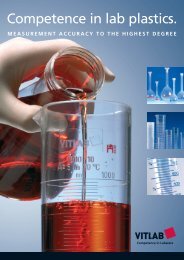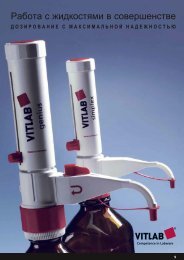AP-370 Series product literature - Horiba
AP-370 Series product literature - Horiba
AP-370 Series product literature - Horiba
Create successful ePaper yourself
Turn your PDF publications into a flip-book with our unique Google optimized e-Paper software.
According to EN14626 and VDI 4202/4203<br />
TUEV Bericht 936/21204643B 05. Jan. 2006 U. S. EPA REFERENCE Equivalent Number RFCA-0506-158<br />
The cross flow modulation type, infrared-absorption technology eliminates<br />
the need for adjusting optical alignment.<br />
For the user, this means very stable and sensitive (5 ppm F.S.) measurements.<br />
The <strong>AP</strong>MA-<strong>370</strong> uses an AS type (antishock) interference-compensating detector, and a purified reference gas.<br />
The reference gas is generated by purging the sample through an oxidation process, where an oxidizing catalyst burns<br />
the CO to CO2. These features eliminate interference from other elements,<br />
resulting in highly accurate measurements.<br />
The <strong>AP</strong>MA-<strong>370</strong> does not use such components as reflecting mirrors, that attract foreign matter.<br />
This means the optical bench stays clean assuring you of stable results over long periods of time.<br />
Principle<br />
Cross flow modulation,<br />
Infrared (NDIR) absorption technology<br />
Conventional technology uses an optical chopper to<br />
obtain modulation signals. Instead, the <strong>AP</strong>MA-<strong>370</strong><br />
uses solenoid valve cross flow modulation. Fixed<br />
amounts of the sample gas and the reference gas<br />
are injected alternately into the measurement cell.<br />
With the cross flow-modulation method, if the same<br />
gas is used for both the sample gas and the reference<br />
gas (e.g., zero gas could be used for both), no<br />
modulation signal will be generated. This has the<br />
great advantage that, in principle, when analyzing<br />
minute amounts of gas there is no generation of<br />
zero-drift. An additional advantage is that the elimination<br />
of rotary sectors precludes the need for<br />
optical adjustment. These features assure greatly<br />
improved stability over long periods of measurement.<br />
A further improvement is that in the front chamber of<br />
the detector, the measurable components, including<br />
interference components, are detected; in the rear<br />
chamber, only interference components are detected.<br />
By means of subtraction processing, the actual<br />
signal obtained is one that has very little interference.<br />
Specifications<br />
Principle: Cross flow modulation, non-dispersive infrared (NDIR) absorption technology<br />
Application: CO in ambient air<br />
Range: Standard ranges: 0-10/20/50/100 ppm; 0-5/10/20/50 ppm; auto range manual range<br />
selectable; can be operated by remote switching.<br />
Optional (measurable) ranges: 4 ranges selectable from 0-100 ppm, within 10 times range<br />
ratio; auto range manual range selectable; can be operated by remote switching.<br />
Lower detectable limit: 0.02 ppm (3 sigma)<br />
Repeatability: 1.0% of F.S.<br />
Linearity: 1.0% of F.S.<br />
Zero drift: LDL/day at lowest range<br />
0.2 ppm/week at lowest range<br />
Span drift: LDL/day at lowest range<br />
1.0% F.S./week<br />
Response time (T90): Within 50 sec at lowest range<br />
Sample gas flow rate: Approx. 1.5L/min<br />
Indication: Measured value, range, alarm, maintenance screen<br />
Alarms: During AIC, zero calibration error, span calibration error, temperature error in catalyzer, etc.<br />
On-screen messages are available in four languages: English, German, French, and Japanese.<br />
Input/output:0-1 V/0-10 V/4-20 mA, to be specified (2 systems: either (1) momentary value and<br />
integrated or (2) moving average value) Contact input/output RS-232C (option)<br />
Ambient temperature: 5-40 <br />
Power: 100/110/115/120/220/230/240 VAC, 50/60 Hz (to be specified)<br />
Dimensions: 430(W)550(D)221(H) mm<br />
Mass: Approx. 16 kg,<br />
calibration<br />
zero gas<br />
inlet<br />
calibration<br />
span gas<br />
inlet<br />
capillary<br />
FS<br />
flow sensor<br />
pressure<br />
sensor<br />
<br />
PS<br />
sample<br />
inlet<br />
F<br />
filter<br />
<br />
MC<br />
analyzer<br />
FS<br />
flow sensor<br />
<br />
P<br />
pump<br />
exhaust<br />
CAT<br />
catalyzer<br />
F BT<br />
filter buffer tank


